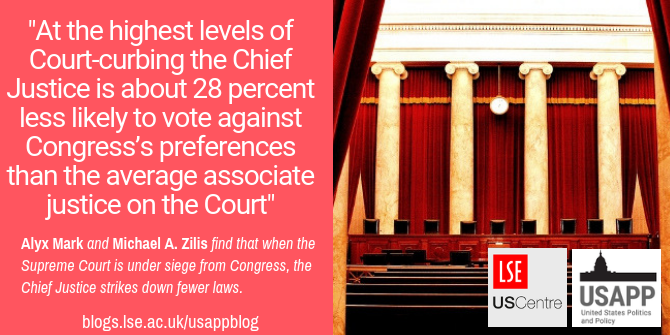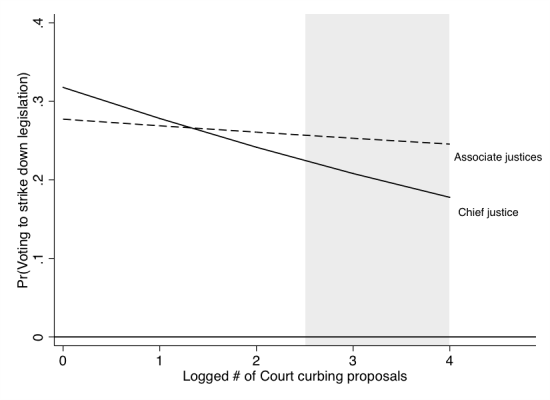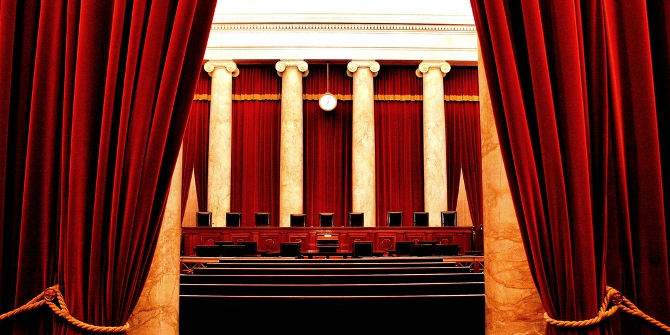
 As we enter the 2020 primary season, many Democratic candidates have suggested measures to reform the Supreme Court, such as increasing the number of Justices. In new research, Alyx Mark and Michael A. Zilis examine how Chief Justices respond to such legislative threats to curb the Supreme Court. They find that when Congress’ Court-curbing tendencies are their highest, Chief Justices are nearly 30 percent less likely to vote against Congress’ wishes than are Associate Justices.
As we enter the 2020 primary season, many Democratic candidates have suggested measures to reform the Supreme Court, such as increasing the number of Justices. In new research, Alyx Mark and Michael A. Zilis examine how Chief Justices respond to such legislative threats to curb the Supreme Court. They find that when Congress’ Court-curbing tendencies are their highest, Chief Justices are nearly 30 percent less likely to vote against Congress’ wishes than are Associate Justices.
Recently, Democratic Congress members and presidential candidates have offered proposals to restructure the US Supreme Court. From Court-packing to cameras in the courtroom to term limits, politicians use Court-curbing proposals to build their bases of support and influence Court decision-making. Indeed, congressional Court-curbing proposals ramp up when proposers perceive that they can receive more favorable policy outcomes by threatening the institution. The Court might be inclined to ignore some of these attacks but for the fact that they convey valuable information about its legitimacy. Senator Kamala Harris’s recent proposal, for example, noted a public “crisis in confidence in the Supreme Court.” The concern is real enough for the Court to limit its use of judicial review – it is less likely to strike down legislation when under siege.
But, this decision-making moderation raises the question – are all Supreme Court justices equally concerned about Court-curbing threats? We argue, in part, that the Chief Justice pays more attention to the environment between different institutions than his colleagues due to the unique role he plays on the Court. As a consequence, he may be more likely to weigh signals from Congress as a component of his decision-making calculus. Thinking about responsiveness at the individual justice level helps us understand why the Court may moderate its behavior in the face of Court-curbing threats in some situations, and not in others.
“First among equals” – with some additional responsibilities
The Chief Justice’s distinct powers and responsibilities make it more likely that he pays attention to the Court’s relationship with Congress. For example, as the presiding officer of the Judicial Conference, the Chief is required to submit an annual report to Congress. In these “State of the Judiciary” reports, the Chief has a special opportunity to display attentiveness to congressional business, and maybe even air his frustrations with Congress. Chief William Justice Rehnquist, in charge of the Court for nearly two decades, devoted an entire section of his 2003 report to “relations between Congress and the Judiciary,” and chastised Congress for not fully consulting the judiciary in its decision to remove judicial discretion in sentencing via the PROTECT Act. In 2008, current Chief Justice John Roberts wrote of his disappointment with Congress for not increasing judicial salaries to keep pace with inflation. Put simply, these reports indicate that the Chief Justices are well aware when Congress is hostile to their Court.

“Supreme Court of the United States” by Phil Roeder is licensed under CC BY 2.0
We also see the Chief’s concerns over the health of their institution manifest itself other ways, like in his opinion assignment behavior. Unlike his associate justice colleagues, the Chief is more likely to assign opinions based on extra-court dynamics like maintaining the relationship between the Court and other political actors.
The Chief Justice’s voting calculus may be different from the associate justices
If the Chief is more concerned with institutional maintenance than his associate justice colleagues due to his unique role on the Court, it follows that he may be more likely to sacrifice his policy goals if the Court’s institutional authority is at stake. As such, at times when inter-institutional hostility is high, the Chief Justice may vote in ways that appear counter to his ideological preferences.
For example, in National Federation of Independent Business v. Sebelius (2012), Roberts surprised some with a carefully crafted opinion that saw him break with the Court’s conservative bloc. Instead, his opinion upholding the central portion of the Affordable Care Act was partly informed by his role as a “cautious conservator of the court’s institutional role.”
Looking across time, and holding things like policy preferences constant, we find that Chief Justice Roberts’s decision in Sebelius was not idiosyncratic – but instead part of a pattern of judicial behavior on the part of Chief Justices over the past six decades. To study this idea, we measured the number of Court-curbing legislative threats in each year and compared it with voting behavior in judicial review cases. Figure 1 shows that the use of judicial review is “responsive” to Congressional threats for the Chief Justice, but not his colleagues. At the highest levels of Court-curbing the Chief Justice is about 28 percent less likely to vote against Congress’s preferences than the average associate justice on the Court.
Figure 1 – Chief Justice Responsiveness to Threats from Congress in Judicial Review Cases

Note: The shaded region represents a significant difference between the chief and associate justices’ propensities to strike down legislation. Substantively, this demonstrates that the chief justice is less likely than his colleagues to vote to strike down legislation as Court-curbing increases.
What this means for inter-institutional relations
How might the Court respond to heightened levels of Court-curbing, or other indicators of hostility in its inter-institutional environment? While Chief Justice Roberts is likely not a “secret liberal,” his new position as the median member of the Court, coupled with his formal role as Chief, leads us to posit that he is more likely to defer to Congress at times of high Court-curbing because of his deep concern for preserving the Court’s power. If true, this suggests that Congress’s threats could have a key influence on Court behavior – but only so long as Roberts continues to provide the pivotal vote in 5-4 rulings.
- This article is based on the paper, ‘The Conditional Effectiveness of Legislative Threats: How Court Curbing Alters the Behavior of (Some) Supreme Court Justices’ in Political Research Quarterly.
Please read our comments policy before commenting
Note: This article gives the views of the author, and not the position of USAPP– American Politics and Policy, nor of the London School of Economics.
Shortened URL for this post: http://bit.ly/2J5Xu9H
About the authors
 Alyx Mark – American Bar Foundation and Wesleyan University (Fall 2019)
Alyx Mark – American Bar Foundation and Wesleyan University (Fall 2019)
Alyx Mark is a Visiting Scholar at the American Bar Foundation and will be joining the Government Department at Wesleyan University in Fall 2019. Her research agenda focuses on how institutions empower and constrain legal elites (lawyers, judges, lawmakers) and members of the mass public. Her research has received the support of the National Science Foundation, the Economic Club of Washington, D.C., and The Edward M. Kennedy Institute for the US Senate. Her work appears in, or is forthcoming in Law and Social Inquiry, Law and Society Review, Legislative Studies Quarterly, Political Research Quarterly, The Journal of Law and Courts, among other outlets.
 Michael A. Zilis – University of Kentucky
Michael A. Zilis – University of Kentucky
Michael A. Zilis is Assistant Professor in the Department of Political Science at the University of Kentucky. His research focuses on politicized resistance to the US Supreme Court from both behavioral and institutional perspectives. His work has been published or is forthcoming at Political Research Quarterly, Legislative Studies Quarterly, Social Science Quarterly, Journal of Law and Courts, Washington University Journal of Law & Policy, and Elon Law Review. His book, The Limits of Legitimacy (University of Michigan Press), explores media coverage and public support for high profile rulings of the Supreme Court and was named an Exemplary Law Book of 2015.



